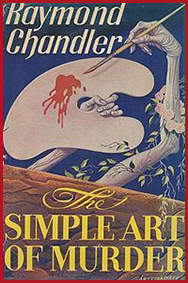THE SIMPLE ART OF MURDER
Chandler, Raymond (Houghton Mifflin, 1950, ISBN 0394757653)
In his remarkable essay, The Simple Art of Murder, Chandler points out that, in the real world, using elaborate means to commit a murder, disguise one or to fabricate an alibi will only serve to incriminate the perpetrator. It gives a methodical police force too much to work with. Instead (if I comprehend Chandler’s meaning), just bludgeon the victim with some commonplace object found near the scene of the crime and when the police ask for your alibi, tell them to go fuck themselves.
One of the pleasures of our lives comes from watching Robert Culp make the preparations for the murder at the start of a week’s Columbo. It gives us the same innocent pleasure as destroying bubble wrap or pronouncing the name ‘Hubert Sumlin‘. We imagine Columbo in court, trying to explain to the jury about the three slow wristwatches, the lady hidden in the cake and the moment when all four windows lined up with the lake.
Double Exposure opens on Culp retrieving a calibre converter from the lamp in his office. He attaches it to a pistol and locks the pistol into a display case on the wall. Next, we watch him dial the thermostat in his building up to eighty-five degrees. Then, in the projectionist’s booth, we watch him splice a photograph of a glass of iced tea into a reel of film. In the same room, he disables one of the building’s three closed-circuit TV monitors.
Back in his office, we wait while he dials the telephone. A middle-aged woman answers. In an assumed voice he tells her that her husband has cheated on her.
The philandering victim arrives with four other businessmen. They’ve come to preview Culp’s latest instructional movie. Every one of them wears a tan suit.
To parch the victim’s throat, Culp feeds him salted beluga caviar before the movie.
When the lights go down in the picture room, Culp uses the tape of his voice to fabricate his alibi. He slips back to his office and retrieves the handgun with its calibre converter from the display case. When at last the subliminal iced tea, heat and caviar send the victim out to the water fountain, Culp shoots him, returns the calibre converter to its lamp, locks the handgun in its display case and returns to the picture room just in time to appear before the others when the lights come up.
We love the show for the magnetism of its eponymous hero. See him hunched forward in that tan raincoat over a darker tan jacket, his shirt a third, yet distinguishable shade of tan.
None of us can help but find the murders preposterous.



Pingback: The State Of The MRB #1 | Melbourne Review of Books